| Manufacturer: | Scratch |
Brief:
This is my first attempt at a kit bash, using a Gemini DC converted into a 3
motor parallel staged cluster that ejects two 13mm motor boosters on steamers,
leaving the 18mm motor sustainers to recover on a 12 inch parachute. I never
would have bother with a project like this, but with the 2006 EMRR challenge
and a Gemini DC kit sat in my "get round to build someday" box, I
thought I'd kill two bird with one stone: a kit bash and a parallel stage
cluster.
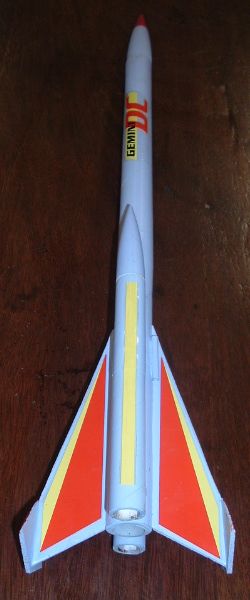
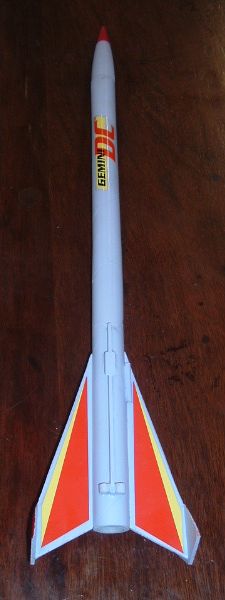
Modifications:
The kit bash is built in three parts: the sustainer and two boosters.
Sustainer construction:
The motor mount is built without the engine hook, the two adapter rings are glued to either end and then glued into the rear of the sustainer body tube.
Remove the four fins from the balsa sheet and then cut the outer bit of the scrap balsa as shown in the photo.
Glue the two pieces of scrap into opposite sides of the tube. These will be the struts that the boosters attach to. Then glue two of the fins into the two remaining slots. Using the two remaining fin, make two side fins (see photo), and glue and fillet these to the end of the two fins that have already fixed into place.
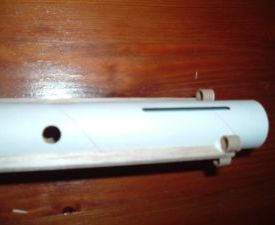
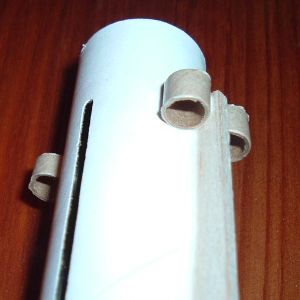
Using the Estes warranty card, cut out two pieces of paper to cover up the gas vent holes.
Glue nose cone adapter and nose cone together. Using the shock cord, a paper shock cord mount, and one of the 12-inch parachutes, make a standard Estes recovery system.
Cut the vent tube into 4 equal pieces and glue each of these pieces to either side of the booster struts so that the base of the tubes are aligned with the base of the booster struts.
Using some of the balsa scrap, make four wedges and again glue these to either sides of the booster struts. The base of the wedges should be about 14mm from the bottom of the sustainer.
Everything now needs to be sanded smooth, especially the struts.
Finally, glue the launch lug to the body tube next to a fin.
Double fillet all joints.
After two flights, it seemed that the sustainer was too light for the boosters and pulled away from them, even though the boosters had a higher thrust. I retro added nose mass by cutting the base off the nose cone and half filling the space with clay.
Booster construction:
I wanted to use 13mm motors for the boosters so that they would burn out way before the sustainer, so I had to make an adapter to change the mount from 18mm to 13mm. To do this, I used the front display card from the bag, cut out four width strips, and glued two strips around a 13mm motor. Using thick epoxy glue, I added a heavy blob to one end of the mounts to act as an engine block. I glued these handmade mounts into the base of the booster tubes.

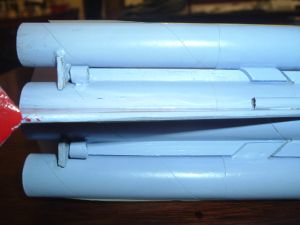
The recovery system for the booster is made from stripping the shroud lines from the remaining parachute. (My kit had pre-made parachutes even though the instructions listed the parachutes as being in pieces.) Streamers were made from the bag that some of the rocket parts came in. The remaining shock cord was cut in half and some paper shock cord mounts comprise the recovery system for each booster.
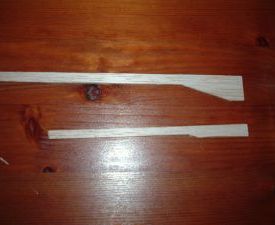 I used some
of the scrap balsa make two "spacers" (see photo). These are then
glued just up from the base of the booster. They should sit below the struts on
the sustainer when the boosters and sustainer are joined.
I used some
of the scrap balsa make two "spacers" (see photo). These are then
glued just up from the base of the booster. They should sit below the struts on
the sustainer when the boosters and sustainer are joined.
Next make four pins from the remaining scrap and glue two pins to each of the spacers. These pins should slide easily into the vent tubes on the sustainer.
Now make four wedges similar to the ones made for the sustainer. These are added to the booster body in pairs so that they fit around the strut on the sustainer and fit flush with the wedges. The sustainer should remain in place when the rocket is held by the boosters, but the boosters should fall away cleanly if the sustainer is held. Fillet and sand as usual.
After a few test flights I added 18g of nose mass.
Finishing:
The entire rocket was spray painted with gray primer and sanded between coats.
I went for a light purple finish with a few highlights of red. The wedges need
to be sanded back to the wood on each spray as the build up of paint could
prevent the boosters from separating cleanly. The decals from the kit were
added where ever they fit.
Flight and Recovery:
The boosters were loaded with A10-3T motors while the sustainer used a B6-4. A
cluster whip was used to ignite the motors.
On the first flight, only the booster motors lit. The sustainer igniter burned but failed to ignite the motor. Everything left the pad, but as the sustainer was still attached to the battery via the whip, everything came down, however, all without damage.
The second flight was 5 minutes later. All three motors lit and the rocket leapt from the pad and at about 50 feet, the boosters separated at the same time but early while still burning causing the booster to flail about the sky. The sustainer flew beautifully straight to about 150 meters.
The sustainer must have been traveling faster than the boosters, which is odd as the A10 booster motor burns with a higher thrust then the B6 motor. After checking SpaceCAD, the reason for the separation was clear: the A10 motor does deliver a higher thrust but only for the fist ¼ of a second then there thrust drops to below 1.5N while the B6 is still delivering just under 5N so the sustainer pulls away leaving the boosters still burning.
One option was to add a significant amount of mass to the nose cone of the sustainer to lower its accelerations (I knew all that F=Ma stuff at school would come in handy eventually). The other option is to change to booster motors to 1/2A3s that burn out after 0.35 seconds but the max peak thrust is too low.
The third flight was done with just the sustainer to see how the extra mass affected the flight. The flight was stable and straight, but the lift off was slower. Unfortunately, the extra mass in the nose cone gave just enough force to separate the nose cone from the body, causing the body to fall to earth giving it a nasty buckle to the body tube.
The fourth flight was perfect. The booster separated cleanly recovering within a few feet of each other. The sustainer continued upward to about 100 meters and also recovered without damage.
I had concerns that only using one 12 inch parachute might not be enough to land the sustainer safely. On all flights with the parachute, the descent was fine and no damage was seen. However, I might consider changing to a 14 inch parachute with a spill hole in the future.
The boosters are light and recovered fine with the streamers.
Summary:
I really enjoyed this project. In the future I will not combine a cluster with
a kit bash though. The separation of the boosters could be made much easier
with the use of a couple of launch lugs, but the kit bash element meant that I
had to use this ugly design.
The main PROs are that its a cluster parallel staging rocket. It does turn a few heads at a launch.
The main CON is that its ugly close up, but then again, it's a real beauty when you see the boosters drop off in mid-flight and the sustainer is still flaming its way up.
 |
 |
Flights
 |
 |